Adult & Pediatric Dermatology
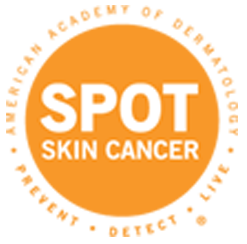
ABCDs MELANOMA
We all love to spend time playing in the sunshine. However, spending too much time in the sun could put you at risk for skin cancer, even if you use sunscreen. Most types of skin cancer are treatable, as long as they are caught early. Dr. Galaria and Christina are trained to evaluate any unusual marks, bumps, sores, or moles on your skin.
Remember to use sunscreen and/or sun-protective clothing as much as possible, and watch your moles regularly for any suspicious changes. The changes you should look for are known as the ABCDs of skin cancer detection.
A stands for asymmetry. Normal moles tend to look symmetrical when compared top to bottom and side to side. When moles are asymmetrical this can be a sign of trouble.
B stands for border irregularity. The borders on normal moles tend to be smooth without notches or “fingers” projecting into the surrounding skin. Moles with notched, jagged, or blurred borders require evaluation by a dermatologist.
C stands for color variation. From mole to mole color may vary from light brown to very dark brown, but within an individual mole, the color should be confluent. Also black, blue, or red colors in moles may signal that the mole is atypical.
D stands for diameter. Any mole lager than 6 mm, or larger than a pencil eraser should be evaluated.
E stands for evolving: If you notice a mole that is growing or which changes, itches, or bleeds you should see a dermatologist. Acne
Acne
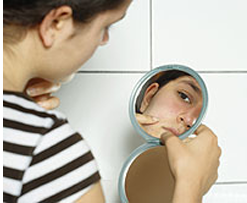
Acne is the term for the blocked pores (blackheads and whiteheads), pimples, and deeper lumps (cysts or nodules) that can appear typically on the face, neck, chest, back, shoulders and upper arms. Seventeen million Americans currently have acne, making it the most common skin disease in the country. While it affects mostly teenagers, and almost all teenagers have some form of acne, adults of any age can have it. Acne is not life-threatening, but it can cause physical disfigurement (scarring) and emotional distress.
Treatment for acne varies depending on the type and severity of lesions, as well as the patient’s skin type, age and life . Options include:
- Topical Medications
- Antibiotics
- Accutane
- Blackhead Extraction
- Microdermabrasion
- Skin Care
- Photodynamic Therapy
- Blu-U Light Treatments
- Laser Treatments
Acne scarring can be treated in a variety of ways as well. These include:
- Laser/Pulsed Light Treatments
- Soft Tissue Fillers
- Dermabrasion / Microdermabrasion
- Chemical Peels
ACTINIC KERATOSES
Actinic keratoses (AKs) are lesions on the surface layer of the skin (epidermis) caused by chronic exposure to sunlight, particularly ultraviolet light. AKs typically manifest as rough or scaly skin, bumps, mottled patterns and cutaneous horns. They may appear anywhere on the skin surface exposed to sunlight, but common areas include the face (including ears and lips), neck, arms and hands. Lesions range in size from a pinpoint to several centimeters in diameter and may be yellow, brown, red or violet, smooth, wrinkled or furrowed.
Actinic keratoses can signal the onset of skin cancer; they can become squamous cell carcinomas, the second-most common form of epidermal skin cancer. Depending on a number of factors such as the size, location and severity of lesions, as well as the patient’s age, health, medical history, occupation, expectations and preferences, treatment for AKs may take the form of traditional surgical excision, cryosurgery (freezing), curettage (scraping), topical medications, laser treatment, chemical peels, dermabrasion and pulsed light therapy. Routine re-examinations every few months and imitation of exposure to direct sunlight are recommended.
Alopecia
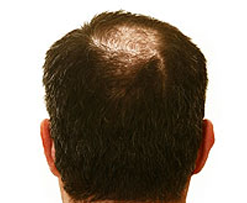
Alopecia, or hair loss, is a common condition caused by a number of reasons. Hair loss can be natural, a side effect of medication or signs of another health condition. It can result in total baldness, patchy bald spots or thinning of the hair, and may be confined to the scalp or affect other areas of the body. Some of the causes of alopecia include:
- Trichotillomania (mental disorder that causes a person to pull out his or her own hair)
- Male pattern baldness
- Chemotherapy
- Fungal infection of the scalp
- Thyroid disorders
Treatment for hair loss is usually based on the cause but can include completion of chemotherapy, treating infections, drug therapy like Rogaine and Proscar or hair transplant plugs.
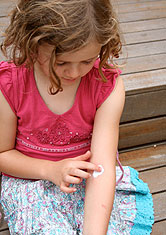
ATOPIC DERMATITIS
Atopic dermatitis, a form of eczema, is a chronic skin disorder that causes dry, itchy skin and often results in a red rash. It is most common in babies and children, and tends to affect those with a family history of allergies and asthma, although the actual cause is unknown.
Atopic dermatitis can affect different areas of the skin but is most commonly found on the face, neck, arms and legs. It is usually mild and can go away on its own, but may be more severe if it affects a larger area.
Although atopic dermatitis cannot be cured, it can usually be treated and controlled simply through using moisturizing lotions, avoiding harsh soaps and controlling scratching.
CHERRY ANGIOMA
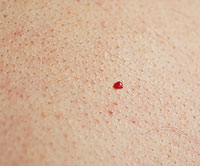
A cherry angioma is a type of growth that appears on the skin as a bright red patch because of a grouping together of blood vessels underneath the skin. They are common skin lesions, especially after the age of 30, and can develop on any part of the body. Cherry angiomas are benign and typically small in size, ranging from a pinpoint to approximately one-quarter inch across. It is not known exactly what causes cherry angiomas to form, but they are often inherited.
Cherry angiomas are usually harmless and require no treatment. However, they tend to bleed profusely when injured because of the concentration of blood cells at the skin’s surface. If the appearance or bleeding of a cherry angioma becomes bothersome, they can quickly and easily be removed. A Dermatologist will determine which method is best depending on a variety of factors, and may choose cautery to burn it off, cryotherapy to freeze it off, laser treatment or excision.
FULL BODY SKIN EXAMS
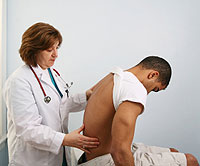
Full-body skin exams are an essential method of screening patients for benign or cancerous lesions that they may not have been able to see or recognize on their own. By using a 5x magnifier and looking at all of your skin, Dr. Galaria can often find potentially life-threatening growths in a timely manner. From head to toe and back to front, she inspects the skin for any suspicious growths. This quick and painless preventive measure is an invaluable tool in the early detection of skin cancer as well as many other dermatological conditions.
Dr. Galaria’s office has the latest OR-type exam lights and electric tables to make such examinations as efficient and effective as possible. There is always a medical assistant present in the room with the doctor and patient. Dr. Galaria likes the patient to look at their skin with her so she can point out the various benign and sometimes malignant growths she sees and then discuss them with the patient.
Medical attention is necessary after noticing any skin changes, as early detection is valuable in successfully treating skin cancer. Regular full body screening is recommended as well. A biopsy is usually performed to accurately diagnose suspected cancerous growths. Full-body skin exams to detect any new moles and growths, as well as to monitor existing growths, are recommended on a yearly basis in order to screen for skin cancer and detect any abnormalities in their earliest stages.
The examination itself does not take long if you have never had any type of cancerous or precancerous finding previously. Dr Galaria will examine your skin from your head to your feet, including often overlooked areas such as the scalp and fingernails, but primarily focusing on any existing moles along the way. Feel free to ask Dr. Galaria for tips on how to perform self-exams at home as well.
FUNGAL INFECTIONS
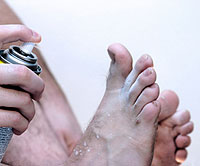
Fungal infections are common skin conditions that may cause redness, itching, burning and scaling. They can also cause blisters or peeling. Fungus can grow anywhere on the body, but tends to develop in warm, moist areas such as the feet, groin and armpit area. Common types of fungal infections include athlete’s foot, jock itch, ringworm and yeast infections.
Fungal infections can usually be successfully treated with antifungal oral or topical medications. They are not usually serious, but maybe contagious, so treatment is important. Keeping the body clean and changing socks and underwear every day can help prevent fungal infections.
Hives
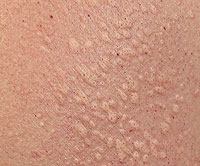
Hives are a common skin condition that may be caused by allergic reactions to medication, food, an insect bite or infection. Hives are swollen, itchy welts on the skin that can appear and disappear suddenly.
They can sometimes burn or sting as well. Hives tend to be harmless and disappear on their own, but can be relieved by applying calamine lotion or taking antihistamines if needed.
Itching

Itching is a skin sensation that can occur anywhere on the body as a result of many different causes. Itching causes a tingling feeling that triggers a need for the skin to be scratched. Some causes of itching include:
- Insect bits
- Sunburn
- Hives
- Dry skin
- Contact dermatitis
- Rashes
- Allergic reactions
Keloids
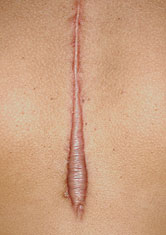
Keloids are overgrown areas of scar tissue that forms at the site of a previous injury such as an incision, wound, vaccination, pimple or piercing. They appear on the skin as an irregularly-shaped pink or red scar that is raised above the rest of the skin and continues to grow into areas that were not affected by the initial injury.
Treatment of keloids depends on the personal preference and desired outcome of the patient. The only true cure for keloids is to prevent them from occurring, but there are several procedures available to help improve the appearance and related symptoms. Some of these treatments help flatten keloids, while others reduce redness and size. Most treatments will leave an irregular mark or texture on the skin.
Keloid treatments include:
- Cortisone injections
- Cryotherapy
- Interferon
- Laser removal
- Surgery
Although keloids are not medically dangerous, many people seek treatment to restore the appearance of their skin and help the keloid become less noticeable over time. Your doctor can help you decide which treatment option is best for you.
Lupus

Lupus is a chronic autoimmune disease in which the immune system attacks the body’s own tissues and organs, causing inflammation and damage to various parts of the body. Lupus is a common disease that affects more than 16,000 people each year. It occurs most frequently in women between the ages of 15 and 45. The cause of lupus is unknown but may be affected by the environment, hormones or other immune system problems. The symptoms of lupus may include:
- Joint pain
- Fatigue
- Fever
- Rashes
- Chest pain
Symptoms usually worsen during flares, which are triggered by certain environmental factors such as stress, not getting enough rest, infection or injury. While lupus cannot be cured, it can usually be managed by avoiding the triggers that cause flares and treating the individual symptoms.
Melanoma

Melanoma is a skin cancer of the melanocytes, the cells that make melanin (brown pigments). Accounting for more than 80 percent of all skin cancer deaths, melanoma is the deadliest form of skin cancer. Early detection and treatment greatly increase the likelihood of total freedom from melanoma.
The earliest, most common symptoms of melanoma are abnormal growths on the skin or changes in existing moles. It is therefore important to seek medical attention upon noticing any abnormal changes in your skin.
Melanoma is usually diagnosed through a full skin exam and a biopsy of the suspicious-looking area. If melanoma is found, a stage will be assigned to it; stage I melanoma is the earliest stage, while stage IV indicates that cancer has spread elsewhere on the body, making treatment more difficult. Melanoma is typically treated by surgically removing the melanoma; later stages of melanoma may also include chemotherapy or radiation therapy to destroy all cancer cells.
Melasma
Melasma is a common skin condition where patches of skin on the face turn brown. The most commonly affected areas are the cheeks, bridge of the nose, forehead and upper lip. Melasma mostly affects women. Causes include exposure to ultraviolet light and hormonal changes resulting from pregnancy or birth control.
Treatments for melasma include:
- UVA/UVB Sunscreen of SPF 30 or higher
- Sunblock Lotions
- Avoidance of Any Irritating Cleansers, Creams or Makeup Products
- Discontinuation of Birth Control
- Bleaching Creams including Hydroquinone
- Glycolic Acid Peels
Treatment by a dermatologist often improves the appearance of melasma and prevents future recurrence.
Moles & Birthmarks
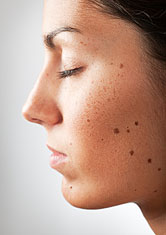
Many moles and birthmarks on the skin are completely benign, and pose no threat to the person on whom they appear, even if they are unsightly.
However, some “moles” may not be harmless. They may be dysplastic nevi, which have the potential to become melanomas. Dysplastic nevi are usually irregular in size, shape and color and border. They can be located on sun-exposed or sun-spared skin areas.
When dysplastic nevi are seen in patients who have a personal or family history of melanoma, the chances are even greater than this mole can become malignant. That is why Dr. Galaria always asks about a history of melanoma from every patient he sees.
Most birthmarks are benign, but some may have a malignant potential, and some may indicate systemic disease. Café au lait spots are evenly tan flat spots on the trunk and may be in the armpit area also. They can indicate internal problems. Many skin changes can be associated with internal diseases, such as losing the lateral third of your eyebrow being associated with thyroid disease.
To be safe, moles exhibiting any of the following warning signs should be examined by Dr. Galaria immediately:
- Larger than six millimeters
- Itches or bleeds
- Rapidly changes in color, size or shape
- Has multiple colors
- Is located where it can’t be easily monitored, such as on the scalp
Depending on their depth, location, and color, as well as the patient’s skin type, age and other factors, treatment for benign but unattractive birthmarks may take the form of laser or pulsed light therapy, microdermabrasion or surgical excision.
Nail Fungus
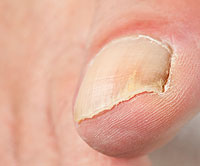
Nail fungal infections occur under the fingernail or toenail as a result of exposure to a warm, moist environment like sweaty shoes or shower floors. These fungal infections usually begin as a yellow or white spot under the nail and develop into thickened, brittle and distorted nails. They may also turn your nails a darker color as a result of the debris building up. Nail fungal infections occur more frequently in toenails because they are more often confined to dark, moist environments.
Nail fungal infections should be treated immediately as they may cause permanent damage and are likely to recur. Treatment options include oral anti-fungal medications, anti-fungal nail polish or other topical medications. The nail may need to be removed in severe infections.
Psoriasis

Psoriasis is a group of chronic skin disorders that cause itching and/or burning, scaling and crusting of the skin. Over seven million men and women in the U.S. of all ages have some form of psoriasis, which may be mild, moderate or severe. The most commonly affected areas are the scalp, elbows, knees, hands, feet, and genitals.
Psoriasis cannot be cured but it can be treated successfully, sometimes for months or years at a time and occasionally even permanently. Treatment depends on the type, severity and location of psoriasis. The patient’s age, medical history and life may also have a significant impact on the methods utilized. The most common treatments are topical medications, phototherapy, photochemotherapy (PUVA), and oral or injectable medication (for severe symptoms).
Rosacea
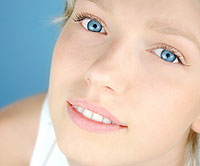
Rosacea is a chronic inflammatory skin condition that causes redness and swelling on the face and occasionally on the neck, ears, chest, back, and eyes as well. The specific cause of rosacea is unknown, but is suspected to involve a combination of hereditary and environmental factors, and is most common in fair-skinned adults between the ages of 30 and 50. Certain triggers, such as consuming alcohol or spicy foods, may worsen symptoms of rosacea.
Treatment for rosacea aims to relieve symptoms and reduce the frequency and severity of flare-ups. This can be done through a combination of approaches, including topical and oral medications, antibiotics, Accutane®, or surgery for severe or permanent symptoms. Your doctor will develop a customized treatment plan after a thorough evaluation of each patient’s individual condition. While there is no cure for rosacea, many patients can achieve effective symptom relief for long periods of time.
Seborrheic Keratoses
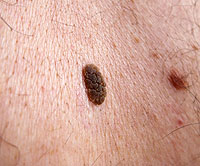
Seborrheic keratosis is a non-cancerous skin growth that commonly affects the elderly. Its exact causes are unknown, although it tends to be hereditary. Seborrheic keratosis is a painless condition that requires no treatment; many individuals, however, choose to have the growth(s) removed for cosmetic purposes.
A seborrheic keratosis typically appears on the head, neck, or trunk. It is usually round or oval shaped, and it may vary in color. In some cases, seborrheic keratosis may itch. Medical attention may be necessary if numerous seborrheic keratoses develop in a short period of time, the seborrheic keratoses interfere with clothing, or other abnormal skin changes occur.
Seborrheic keratosis is diagnosed by inspecting the affected area. A biopsy may be taken to rule out skin cancer. Seborrheic keratoses require no treatment. If removal is requested for cosmetic purposes, it may be achieved through cryosurgery, curettage, or electrocautery.
Skin Cancer
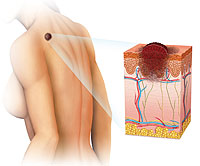
Skin cancer refers to the abnormal, uncontrolled growth of skin cells. One in five people will develop skin cancer in their lifetime, according to the American Academy of Dermatology. Risk factors include pale skin, family history of melanoma, being over 40 years old, and regular sun exposure. Fortunately, skin cancer is almost always curable if detected and treated early.
The most common skin cancers are:
Basal Cell Carcinoma – 80-85% of all skin cancers. Basal cell carcinoma affects cells in the lowest layer of the epidermis.
Squamous Cell Carcinoma – 10% of all skin cancers. Squamous cell carcinoma affects cells in the middle layer of the epidermis.
Melanoma – 5% of all skin cancers. Melanoma is a rare but very dangerous type of skin cancer. It is the leading cause of death from skin disease.
Skin cancers vary in shape, color, size, and texture, so any new, changed or otherwise suspicious growths or rashes should be examined immediately by a physician. Early intervention is essential to preventing cancer from spreading.
Spider Veins
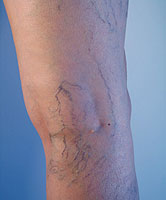
Spider veins, or telangiectasias, are small, thin, blood vessels visible beneath the skin. They appear most commonly on the face and legs and may look like a series of lines, tree branches, or a spider- or web-like shape with a dark center. It is estimated that they affect nearly half of adult women in the U.S.
Spider veins are caused by a variety of factors, including heredity, pregnancy (and other conditions that , nvolve changes in hormone levels), weight gain, long periods of standing, and certain medications. They often appear red or blue, and because they form on the face, thighs, calves and ankles, many patients are bothered by the way they look. Others seek medical treatment for uncomfortable symptoms such as aching, burning, swelling and cramping. The standard treatments for spider veins are sclerotherapy and laser or pulsed light treatments.

Sun Spots
Sun damage can affect any area of your skin as a result of long-term exposure to the ultraviolet (UV) rays of the sun. Sun damage most commonly occurs on the face, hands, and arms, and may lead to sunspots.
The best treatment against sunspots is preventing it from occurring in the first place. It is important to wear sunscreen lotion on a daily basis and avoid excessive exposure to the sun, especially during mid-day hours when the sun is strongest. Existing sunspots can be treated through skin procedures like chemical peels, microdermabrasion and intense pulsed light therapy.
Warts/Molluscum
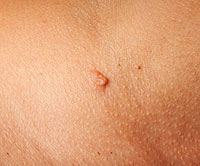
Warts are skin growths caused by viruses. Different warts respond to different treatments; some go away on their own. Salicylic acid products (in the form of drops, gels, pads, and bandages) can help self-treatment of many warts by dissolving the keratin protein that makes up the wart and the dead skin above it. Others can be removed via liquid nitrogen freezing or electrical stimulation. Surgery may be recommended for painful or large warts that do not respond to these treatments.
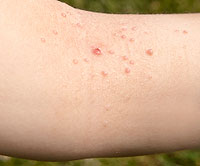
The best treatment against sunspots is preventing it from occurring in the first place. It is important to wear sunscreen lotion on a daily basis and avoid excessive exposure to the sun, especially during mid-day hours when the sun is strongest. Existing sunspots can be treated through skin procedures like chemical peels, microdermabrasion and intense pulsed light therapy.
Patients with healthy immune systems generally find that molluscum contagiosum clears on its own within six to 18 months. Patients should try not to scratch the papules, or else they risk scarring and bacterial infection. If necessary, our doctors can remove individual lesions.
 703-327-3173
703-327-3173

